Deck 24: Carbon-Carbon Bond-Forming Reactions in Organic Synthesis
Question
Question
Question
Question
Question
Question
Question
Question
Question
Question
Question
Question
Question
Question
Question
Question
Question
Question
Question
Question
Question
Question
Question
Question
Question
Question
Question
Question
Question
Question
Question
Question
Question
Question
Question
Question
Question
Question
Question
Question
Question
Question
Question
Question
Question
Question
Question

Unlock Deck
Sign up to unlock the cards in this deck!
Unlock Deck
Unlock Deck
1/47
Play
Full screen (f)
Deck 24: Carbon-Carbon Bond-Forming Reactions in Organic Synthesis
1
What is the missing reactant in the following reaction? 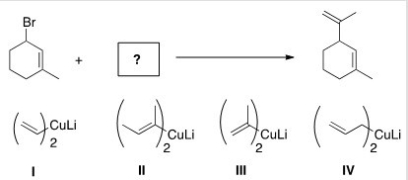
A)I
B)II
C)III
D)IV

A)I
B)II
C)III
D)IV
III
2
Which of the following statements is not true about a carbene?
A)A carbene is a neutral reactive intermediate.
B)A carbene contains a divalent carbon.
C)A carbene is sp3 hybridized.
D)A carbene is surrounded by six electrons.
A)A carbene is a neutral reactive intermediate.
B)A carbene contains a divalent carbon.
C)A carbene is sp3 hybridized.
D)A carbene is surrounded by six electrons.
A carbene is sp3 hybridized.
3
Which of the following correctly describes a reaction yielding a dichorocarbene?
A)The reaction of chloroform with KOC(CH3)3
B)The reaction of chloroform with Zn(Cu)
C)The reaction of chloroform with (CH3)2CuLi
D)The reaction of diazomethane with KOC(CH3)3
A)The reaction of chloroform with KOC(CH3)3
B)The reaction of chloroform with Zn(Cu)
C)The reaction of chloroform with (CH3)2CuLi
D)The reaction of diazomethane with KOC(CH3)3
The reaction of chloroform with KOC(CH3)3
4
Which of the reactions listed below is not stereospecific?
A)Suzuki reaction
B)Organocuprate coupling reaction
C)Heck reaction
D)Simmons-Smith reaction
A)Suzuki reaction
B)Organocuprate coupling reaction
C)Heck reaction
D)Simmons-Smith reaction

Unlock Deck
Unlock for access to all 47 flashcards in this deck.
Unlock Deck
k this deck
5
Which statement below best explains what is meant by the statement,"An organocuprate reaction with a vinyl halide is stereospecific"?
A)The reaction of a specific stereoisomer with the R2CuLi reagent will yield that particular stereoisomer as the product.
B)The reaction of a vinyl halide with the R2CuLi reagent will only yield the cis product.
C)The reaction of a vinyl halide with the R2CuLi reagent will only yield the trans product.
D)The reaction of a vinyl halide with the R2CuLi reagent will only yield one enantiomer product-either R or S configuration.
A)The reaction of a specific stereoisomer with the R2CuLi reagent will yield that particular stereoisomer as the product.
B)The reaction of a vinyl halide with the R2CuLi reagent will only yield the cis product.
C)The reaction of a vinyl halide with the R2CuLi reagent will only yield the trans product.
D)The reaction of a vinyl halide with the R2CuLi reagent will only yield one enantiomer product-either R or S configuration.

Unlock Deck
Unlock for access to all 47 flashcards in this deck.
Unlock Deck
k this deck
6
Which class of compounds listed below does not react with organocuprate reagents to form a coupling product that contains a new carbon-carbon bond?
A)1° Alkyl halides
B)3° Alkyl halides
C)Vinyl halides
D)Aryl halides
A)1° Alkyl halides
B)3° Alkyl halides
C)Vinyl halides
D)Aryl halides

Unlock Deck
Unlock for access to all 47 flashcards in this deck.
Unlock Deck
k this deck
7
What products are formed when diazomethane is heated?
A)Methane gas and nitrogen gas
B)Propene gas and nitrogen gas
C)Methyl radical and nitrogen gas
D)Methylene and nitrogen gas
A)Methane gas and nitrogen gas
B)Propene gas and nitrogen gas
C)Methyl radical and nitrogen gas
D)Methylene and nitrogen gas

Unlock Deck
Unlock for access to all 47 flashcards in this deck.
Unlock Deck
k this deck
8
What is the major organic product of the following reaction? 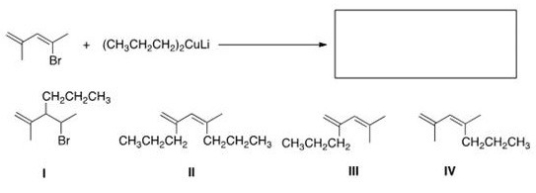
A)I
B)II
C)III
D)IV

A)I
B)II
C)III
D)IV

Unlock Deck
Unlock for access to all 47 flashcards in this deck.
Unlock Deck
k this deck
9
Which of the following statements is not true about the Simmons-Smith reaction?
A)The Simmons-Smith reaction involves the formation of a free carbene.
B)The Simmons-Smith reaction uses the reagents zinc-copper couple.
C)The Simmons-Smith reaction is stereospecific.
D)The Simmons-Smith reaction involves CH2I2 reacting with a copper-activated zinc reagent.
A)The Simmons-Smith reaction involves the formation of a free carbene.
B)The Simmons-Smith reaction uses the reagents zinc-copper couple.
C)The Simmons-Smith reaction is stereospecific.
D)The Simmons-Smith reaction involves CH2I2 reacting with a copper-activated zinc reagent.

Unlock Deck
Unlock for access to all 47 flashcards in this deck.
Unlock Deck
k this deck
10
Organocuprate reagents (R2CuLi)react with several compounds.Which listed reaction is not correct?
A)Acid chlorides react with organocuprate reagents to form ketones.
B)Epoxides react with organocuprate reagents to form alcohols.
C)Alkyl halides react with organocuprate reagents to form coupling products containing a new carbon-carbon bond.
D)Carbon dioxide reacts with organocuprate reagents to form carboxylic acids.
A)Acid chlorides react with organocuprate reagents to form ketones.
B)Epoxides react with organocuprate reagents to form alcohols.
C)Alkyl halides react with organocuprate reagents to form coupling products containing a new carbon-carbon bond.
D)Carbon dioxide reacts with organocuprate reagents to form carboxylic acids.

Unlock Deck
Unlock for access to all 47 flashcards in this deck.
Unlock Deck
k this deck
11
What do the Suzuki reaction,the Heck reaction,and the organocuprate reaction all have in common when they react with an alkyl halide?
A)All reactions form new carbon-carbon bonds.
B)They all use palladium as a catalyst in one step of the reaction.
C)They are all stereospecific reactions.
D)They all require harsh conditions.
A)All reactions form new carbon-carbon bonds.
B)They all use palladium as a catalyst in one step of the reaction.
C)They are all stereospecific reactions.
D)They all require harsh conditions.

Unlock Deck
Unlock for access to all 47 flashcards in this deck.
Unlock Deck
k this deck
12
What is the major organic product of the following reaction? 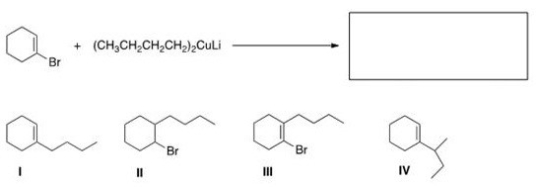
A)I
B)II
C)III
D)IV

A)I
B)II
C)III
D)IV

Unlock Deck
Unlock for access to all 47 flashcards in this deck.
Unlock Deck
k this deck
13
Identify the products of the following reaction. 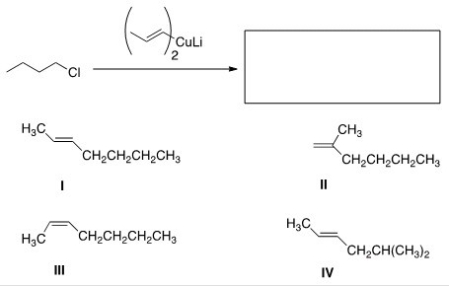
A)I
B)II
C)III
D)IV

A)I
B)II
C)III
D)IV

Unlock Deck
Unlock for access to all 47 flashcards in this deck.
Unlock Deck
k this deck
14
Identify the products of the following reaction. 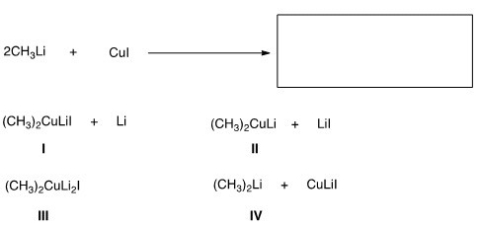
A)A
B)B
C)C
D)D

A)A
B)B
C)C
D)D

Unlock Deck
Unlock for access to all 47 flashcards in this deck.
Unlock Deck
k this deck
15
Choose the statement below that is not true about the Suzuki reaction.
A)The product of the Suzuki reaction is completely stereospecific.
B)The Suzuki reaction involves both an organoborane reagent and an organopalladium catalyst.
C)The Suzuki reaction forms more highly substituted alkenes.
D)The Suzuki reaction involves an oxidative addition followed by a reductive elimination.
A)The product of the Suzuki reaction is completely stereospecific.
B)The Suzuki reaction involves both an organoborane reagent and an organopalladium catalyst.
C)The Suzuki reaction forms more highly substituted alkenes.
D)The Suzuki reaction involves an oxidative addition followed by a reductive elimination.

Unlock Deck
Unlock for access to all 47 flashcards in this deck.
Unlock Deck
k this deck
16
Which of the following is not a step in the Suzuki reaction?
A)Oxidative addition of R-X to the palladium catalyst
B)Substitution of the R group to the palladium catalyst
C)Transfer of the alkyl group from the organoborane to palladium
D)Reductive elimination of R-R,forming the new C-C bond
A)Oxidative addition of R-X to the palladium catalyst
B)Substitution of the R group to the palladium catalyst
C)Transfer of the alkyl group from the organoborane to palladium
D)Reductive elimination of R-R,forming the new C-C bond

Unlock Deck
Unlock for access to all 47 flashcards in this deck.
Unlock Deck
k this deck
17
Which of the following is true about the use of the Grubbs catalyst?
A)The Grubbs catalyst is used in carbon-carbon coupling reactions.
B)The Grubbs catalyst is used in alkene metathesis.
C)The Grubbs catalyst is used in carbene formation.
D)The Grubbs catalyst is used with palladium as a co-catalyst.
A)The Grubbs catalyst is used in carbon-carbon coupling reactions.
B)The Grubbs catalyst is used in alkene metathesis.
C)The Grubbs catalyst is used in carbene formation.
D)The Grubbs catalyst is used with palladium as a co-catalyst.

Unlock Deck
Unlock for access to all 47 flashcards in this deck.
Unlock Deck
k this deck
18
Coupling reactions with vinyl halides are stereospecific.Which choice below best describes the expected product when trans-1-bromo-1-hexene reacts with (CH3)2CuLi?
A)The reaction will only yield a trans-alkene.
B)The reaction will only yield a cis-alkene.
C)The reaction will only yield one enantiomeric product with R configuration.
D)The reaction will only yield one enantiomeric product with S configuration.
A)The reaction will only yield a trans-alkene.
B)The reaction will only yield a cis-alkene.
C)The reaction will only yield one enantiomeric product with R configuration.
D)The reaction will only yield one enantiomeric product with S configuration.

Unlock Deck
Unlock for access to all 47 flashcards in this deck.
Unlock Deck
k this deck
19
Which of the following descriptions does not apply to methylene?
A)Methylene is sp2 hybridized.
B)Methylene is a neutral,reactive intermediate.
C)Methylene is a radical intermediate.
D)The formula of methylene is :CH2.
A)Methylene is sp2 hybridized.
B)Methylene is a neutral,reactive intermediate.
C)Methylene is a radical intermediate.
D)The formula of methylene is :CH2.

Unlock Deck
Unlock for access to all 47 flashcards in this deck.
Unlock Deck
k this deck
20
What is the major organic product of the following reaction? 
A)I
B)II
C)III
D)IV

A)I
B)II
C)III
D)IV

Unlock Deck
Unlock for access to all 47 flashcards in this deck.
Unlock Deck
k this deck
21
Compound X can be synthesized via a ring-closing metathesis reaction when treated with a Grubbs' catalyst.What is a possible structure of the starting material for this reaction? 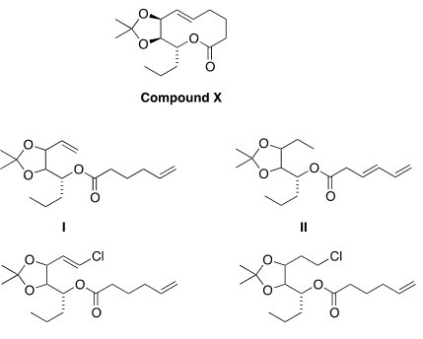
A)I
B)II
C)III
D)IV

A)I
B)II
C)III
D)IV

Unlock Deck
Unlock for access to all 47 flashcards in this deck.
Unlock Deck
k this deck
22
Identify the starting material that would be used to form the following product in a ring-closing metathesis reaction utilizing a Grubbs catalyst? 
A)I
B)II
C)III
D)IV

A)I
B)II
C)III
D)IV

Unlock Deck
Unlock for access to all 47 flashcards in this deck.
Unlock Deck
k this deck
23
Identify the major organic product of the following reaction. 
A)I
B)II
C)III
D)IV

A)I
B)II
C)III
D)IV

Unlock Deck
Unlock for access to all 47 flashcards in this deck.
Unlock Deck
k this deck
24
Identify the structure of the major organic product that results from the following reaction. 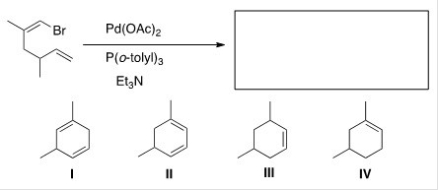
A)I
B)II
C)III
D)IV

A)I
B)II
C)III
D)IV

Unlock Deck
Unlock for access to all 47 flashcards in this deck.
Unlock Deck
k this deck
25
What starting material could yield the following compound if Simmons-Smith conditions were used? 
A)I
B)II
C)III
D)IV

A)I
B)II
C)III
D)IV

Unlock Deck
Unlock for access to all 47 flashcards in this deck.
Unlock Deck
k this deck
26
Many of the reactions studied in this chapter are stereospecific.Why are stereospecific reactions important?
A)When a reaction produces a mixture of enantiomers,it is often very difficult to separate them.A mixture of products is often not useful.
B)Often stereoisomers of a particular compound will have very different biological effects on an organism.Only one isomer is biologically helpful,and the other may be harmful.
C)Often only one stereoisomer is biologically active,and coupling reactions are often used for the production of biological materials.
D)All of the choices are true.
A)When a reaction produces a mixture of enantiomers,it is often very difficult to separate them.A mixture of products is often not useful.
B)Often stereoisomers of a particular compound will have very different biological effects on an organism.Only one isomer is biologically helpful,and the other may be harmful.
C)Often only one stereoisomer is biologically active,and coupling reactions are often used for the production of biological materials.
D)All of the choices are true.

Unlock Deck
Unlock for access to all 47 flashcards in this deck.
Unlock Deck
k this deck
27
Identify the structure of the organic product Y formed in the following reaction sequence. 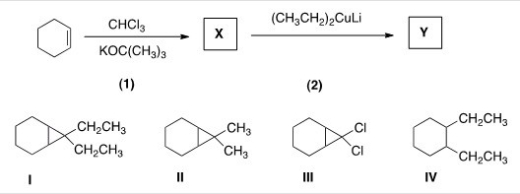
A)I
B)II
C)III
D)IV

A)I
B)II
C)III
D)IV

Unlock Deck
Unlock for access to all 47 flashcards in this deck.
Unlock Deck
k this deck
28
What is the name for the type of intermediate X formed in the reaction sequence below? 
A)A carbocation
B)A carbanion
C)A free radical
D)A carbene

A)A carbocation
B)A carbanion
C)A free radical
D)A carbene

Unlock Deck
Unlock for access to all 47 flashcards in this deck.
Unlock Deck
k this deck
29
What is the appropriate sequence of reagents that will produce the target molecule shown below from ethylbenzene? 
A)(1)HBr,H2O2; (2)KOC(CH3)3 ; (3)MCPBA; (4)CH2=CPh2
B)(1)NBS,hn ; (2)KOC(CH3)3 ; (3)CHBr3,KO(CH3)3 ; (4)a.LiCuPh2,b.H2O
C)(1)H2SO4(aq.),D ; (2)MCPBA; (3)CHBr3,KO(CH3)3 ; (4)CH2=CPh2
D)(1)Br2,FeBr3 ; (2)MCPBA; (3)CHBr3,KO(CH3)3 ; (4)Ph2COCl

A)(1)HBr,H2O2; (2)KOC(CH3)3 ; (3)MCPBA; (4)CH2=CPh2
B)(1)NBS,hn ; (2)KOC(CH3)3 ; (3)CHBr3,KO(CH3)3 ; (4)a.LiCuPh2,b.H2O
C)(1)H2SO4(aq.),D ; (2)MCPBA; (3)CHBr3,KO(CH3)3 ; (4)CH2=CPh2
D)(1)Br2,FeBr3 ; (2)MCPBA; (3)CHBr3,KO(CH3)3 ; (4)Ph2COCl

Unlock Deck
Unlock for access to all 47 flashcards in this deck.
Unlock Deck
k this deck
30
Identify the structure of the organic product Y formed in the following reaction sequence. 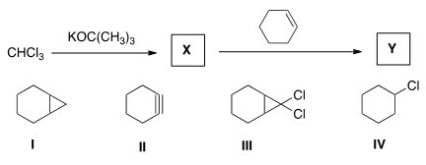
A)I
B)II
C)III
D)IV

A)I
B)II
C)III
D)IV

Unlock Deck
Unlock for access to all 47 flashcards in this deck.
Unlock Deck
k this deck
31
What would be the major organic product of the following Heck reaction? 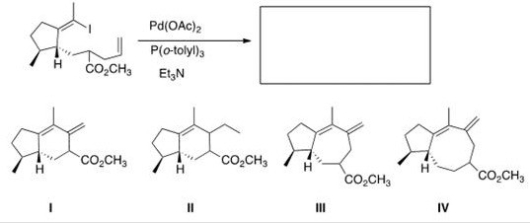
A)I
B)II
C)III
D)IV

A)I
B)II
C)III
D)IV

Unlock Deck
Unlock for access to all 47 flashcards in this deck.
Unlock Deck
k this deck
32
What is the major organic product of the following reaction? 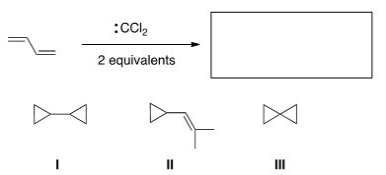
A)I
B)II
C)III
D)None of the choices is correct.

A)I
B)II
C)III
D)None of the choices is correct.

Unlock Deck
Unlock for access to all 47 flashcards in this deck.
Unlock Deck
k this deck
33
Dichlorocarbene reacts with an alkene to form a cyclopropane derivative.In this reaction the dichlorocarbene acts as a(n)
A)Lewis base.
B)electrophile.
C)nucleophile.
D)Brønsted-Lowry base.
A)Lewis base.
B)electrophile.
C)nucleophile.
D)Brønsted-Lowry base.

Unlock Deck
Unlock for access to all 47 flashcards in this deck.
Unlock Deck
k this deck
34
What would be the starting material for the following product that was made via a Grubbs catalyst? 
A)I
B)II
C)III
D)IV

A)I
B)II
C)III
D)IV

Unlock Deck
Unlock for access to all 47 flashcards in this deck.
Unlock Deck
k this deck
35
Why is the Grubbs catalyst synthetically important?
A)Because it only requires dilute concentrations of the reactants
B)Because it produces only stereospecific products
C)Because it produces only stereoselective products
D)Because it provides a synthetic pathway for ring-closing metathesis reactions
A)Because it only requires dilute concentrations of the reactants
B)Because it produces only stereospecific products
C)Because it produces only stereoselective products
D)Because it provides a synthetic pathway for ring-closing metathesis reactions

Unlock Deck
Unlock for access to all 47 flashcards in this deck.
Unlock Deck
k this deck
36
What is the major organic product of the following reaction? 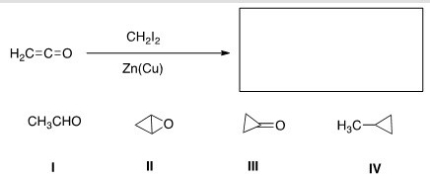
A)I
B)II
C)III
D)IV

A)I
B)II
C)III
D)IV

Unlock Deck
Unlock for access to all 47 flashcards in this deck.
Unlock Deck
k this deck
37
What starting material could yield the following compound if Simmons-Smith conditions were used? 
A)I
B)II
C)III
D)IV

A)I
B)II
C)III
D)IV

Unlock Deck
Unlock for access to all 47 flashcards in this deck.
Unlock Deck
k this deck
38
Identify the major organic product of the following reaction. 
A)I
B)II
C)III
D)IV

A)I
B)II
C)III
D)IV

Unlock Deck
Unlock for access to all 47 flashcards in this deck.
Unlock Deck
k this deck
39
As shown below,when cis-2-butene reacts with dichlorocarbene,only the cis-1,1-dichloro-2,3-dimethylcyclopropane is formed.What can we conclude about the nature of the reaction mechanism? 
A)The mechanism is an SN1 mechanism.
B)The mechanism is a concerted.
C)The mechanism proceeds through a radical intermediate.
D)The mechanism is an E2 mechanism.

A)The mechanism is an SN1 mechanism.
B)The mechanism is a concerted.
C)The mechanism proceeds through a radical intermediate.
D)The mechanism is an E2 mechanism.

Unlock Deck
Unlock for access to all 47 flashcards in this deck.
Unlock Deck
k this deck
40
Identify the major organic product of the following reaction. 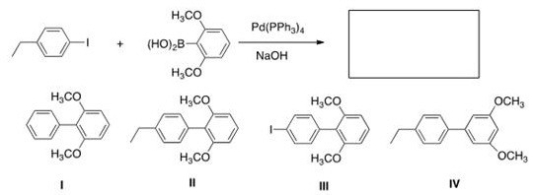
A)I
B)II
C)III
D)IV

A)I
B)II
C)III
D)IV

Unlock Deck
Unlock for access to all 47 flashcards in this deck.
Unlock Deck
k this deck
41
Starting with chloroform,what reactions order and reagents are necessary to produce the following product and its enantiomer? ![<strong>Starting with chloroform,what reactions order and reagents are necessary to produce the following product and its enantiomer? </strong> A)[1] KOC(CH<sub>3</sub>)<sub>3</sub>,[2] trans-2-butene B)[1] KOC(CH<sub>3</sub>)<sub>3</sub>,[2] cis-2-butene C)[1] trans-2-butene,[2] KOC(CH<sub>3</sub>)<sub>3</sub> D)[1] cis-2-butene,[2] KOC(CH<sub>3</sub>)<sub>3</sub>](https://d2lvgg3v3hfg70.cloudfront.net/TB7662/11eac43c_f782_12a1_a9af_01bc7f46e148_TB7662_00.jpg)
A)[1] KOC(CH3)3,[2] trans-2-butene
B)[1] KOC(CH3)3,[2] cis-2-butene
C)[1] trans-2-butene,[2] KOC(CH3)3
D)[1] cis-2-butene,[2] KOC(CH3)3
![<strong>Starting with chloroform,what reactions order and reagents are necessary to produce the following product and its enantiomer? </strong> A)[1] KOC(CH<sub>3</sub>)<sub>3</sub>,[2] trans-2-butene B)[1] KOC(CH<sub>3</sub>)<sub>3</sub>,[2] cis-2-butene C)[1] trans-2-butene,[2] KOC(CH<sub>3</sub>)<sub>3</sub> D)[1] cis-2-butene,[2] KOC(CH<sub>3</sub>)<sub>3</sub>](https://d2lvgg3v3hfg70.cloudfront.net/TB7662/11eac43c_f782_12a1_a9af_01bc7f46e148_TB7662_00.jpg)
A)[1] KOC(CH3)3,[2] trans-2-butene
B)[1] KOC(CH3)3,[2] cis-2-butene
C)[1] trans-2-butene,[2] KOC(CH3)3
D)[1] cis-2-butene,[2] KOC(CH3)3

Unlock Deck
Unlock for access to all 47 flashcards in this deck.
Unlock Deck
k this deck
42
Starting with chloroform,what reactions order and reagents are necessary to produce the following product? ![<strong>Starting with chloroform,what reactions order and reagents are necessary to produce the following product? </strong> A)[1] KOC(CH<sub>3</sub>)<sub>3</sub>,[2] trans-2-butene B)[1] KOC(CH<sub>3</sub>)<sub>3</sub>,[2] cis-2-butene C)[1] trans-2-butene,[2] KOC(CH<sub>3</sub>)<sub>3</sub> D)[1] cis-2-butene,[2] KOC(CH<sub>3</sub>)<sub>3</sub>](https://d2lvgg3v3hfg70.cloudfront.net/TB7662/11eac43c_f782_39b2_a9af_83be2ce6a9b3_TB7662_00.jpg)
A)[1] KOC(CH3)3,[2] trans-2-butene
B)[1] KOC(CH3)3,[2] cis-2-butene
C)[1] trans-2-butene,[2] KOC(CH3)3
D)[1] cis-2-butene,[2] KOC(CH3)3
![<strong>Starting with chloroform,what reactions order and reagents are necessary to produce the following product? </strong> A)[1] KOC(CH<sub>3</sub>)<sub>3</sub>,[2] trans-2-butene B)[1] KOC(CH<sub>3</sub>)<sub>3</sub>,[2] cis-2-butene C)[1] trans-2-butene,[2] KOC(CH<sub>3</sub>)<sub>3</sub> D)[1] cis-2-butene,[2] KOC(CH<sub>3</sub>)<sub>3</sub>](https://d2lvgg3v3hfg70.cloudfront.net/TB7662/11eac43c_f782_39b2_a9af_83be2ce6a9b3_TB7662_00.jpg)
A)[1] KOC(CH3)3,[2] trans-2-butene
B)[1] KOC(CH3)3,[2] cis-2-butene
C)[1] trans-2-butene,[2] KOC(CH3)3
D)[1] cis-2-butene,[2] KOC(CH3)3

Unlock Deck
Unlock for access to all 47 flashcards in this deck.
Unlock Deck
k this deck
43
What is the major product of the following reaction? 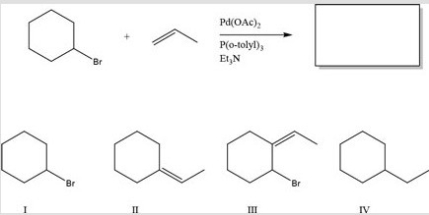
A)I
B)II
C)III
D)IV

A)I
B)II
C)III
D)IV

Unlock Deck
Unlock for access to all 47 flashcards in this deck.
Unlock Deck
k this deck
44
What is the appropriate sequence of starting material and reagents that will produce the target molecule shown below? 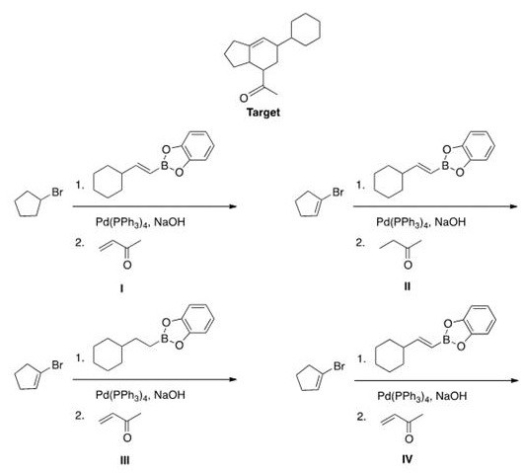
A)I
B)II
C)III
D)IV

A)I
B)II
C)III
D)IV

Unlock Deck
Unlock for access to all 47 flashcards in this deck.
Unlock Deck
k this deck
45
Identify the structure of the major organic product that results from the following reaction. 
A)I
B)II
C)III
D)IV

A)I
B)II
C)III
D)IV

Unlock Deck
Unlock for access to all 47 flashcards in this deck.
Unlock Deck
k this deck
46
Identify the structure of the major organic product that results from the following reaction. 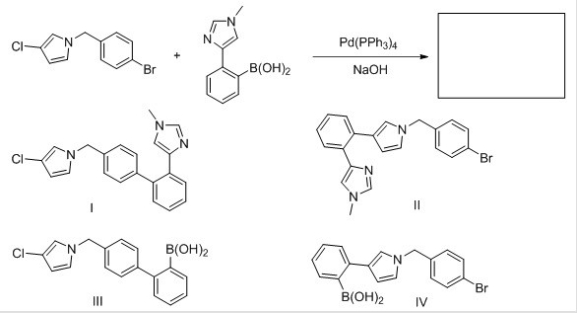
A)I
B)II
C)III
D)IV

A)I
B)II
C)III
D)IV

Unlock Deck
Unlock for access to all 47 flashcards in this deck.
Unlock Deck
k this deck
47
What reactant would be necessary to produce the product indicated in the following reaction? 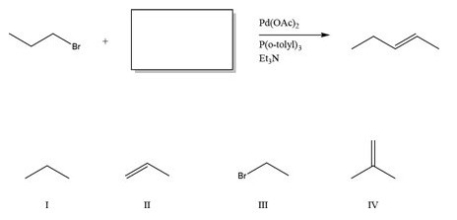
A)I
B)II
C)III
D)IV

A)I
B)II
C)III
D)IV

Unlock Deck
Unlock for access to all 47 flashcards in this deck.
Unlock Deck
k this deck



